Vocabulary Instruction: Strategies for the Classroom
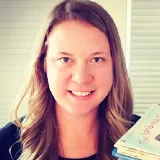
Once a student has learned the alphabetic code, their vocabulary knowledge is the strongest predictor of reading comprehension. But how do we know which words to teach our students? And what is the best way to teach these words? Choosing rich vocabulary for instruction, preplanning vocabulary routines, and creating a vocabulary-rich classroom are all research-based ways to promote student vocabulary development.
Choosing Words for Instruction
It is impossible to directly teach all the vocabulary words that a student needs to learn in their academic career. So, we must be intentional about the words we teach directly, the words students encounter incidentally, and the skills we teach for learning vocabulary independently.
Research supports the idea that we can explicitly teach about 10 to 12 words per week and about three to five words per text. These are the words we teach in depth. Often called Tier 2 words, they share these characteristics:
- Students don’t already know them
- They are critical for understanding the central themes and main ideas in the text
- They are likely to come up in other books, subjects, grade levels, etc.
- They are difficult to learn from context and require more than a brief explanation
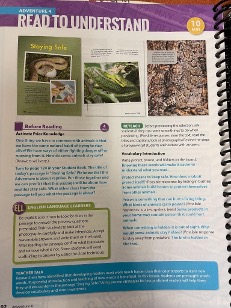
Each Voyager Passport® Read to Understand lesson includes three Tier 2 vocabulary words that are explicitly taught before reading.
In contrast to words we teach deeply, we can teach many other words quickly by giving a synonym, a quick definition, or an example. We don’t need to spend valuable instructional time on these words, but it is worth a brief explanation to help expand our students’ vocabulary breadth. Dr. Nancy Hennessy, in her book The Reading Comprehension Blueprint, calls this teaching style “incidentally-on-purpose” and I love the intentionality of that phrase!
As the demands for reading to learn increase, students will inevitably encounter new vocabulary in their independent reading. To support this, we can teach students to self-monitor for unknown words, and we can teach strategies for inferring their meanings. These strategies will serve our students long after they leave our classroom. They include:
- Modeling how to look for context clues, such as synonyms, antonyms, definitions, or examples, that give clues to a word’s meaning
- Modeling how to look for morphemes (prefixes, suffixes, and root words) that hint at a word’s meaning
- Teaching students how to look up words in physical or online dictionaries for times when context isn’t enough
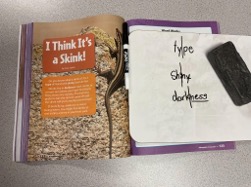
Before reading in a Voyager Passport Read to Understand lesson, a student has identified the syllables and morphemes in their vocabulary words.
Planning for Instruction
Quality vocabulary instruction requires teachers to preplan the vocabulary words they will teach from the specific texts they are using in their classroom. When teaching words explicitly, a vocabulary routine is a helpful way for teachers to plan and deliver instruction. The routine below is one that I have adapted from my LETRS® training. You can find a copy to edit here.
Explicit Vocabulary Routine:
- Pronounce it, write it, read it.
- Call attention to the word’s pronunciation and spelling. Have students pronounce and write the word too. Check student pronunciation. Point out relevant regular and irregular spelling patterns and syllable types in the word.
- Give a student-friendly definition.
- Give a definition using words that your students will understand. Use concrete examples, pictures, videos, and gestures. Explain the word’s connection to other words. Point out any helpful morphemes.
- Say more about the word.
- Use the word in sentences. Explain any multiple meanings. Discuss the word’s part of speech and how to use the word in sentences. Give examples and nonexamples.
- Ask students yes or no questions about the word.
- Have students use the word.
- Support students with sentence stems and questions. Have students talk with a partner and write, when possible.
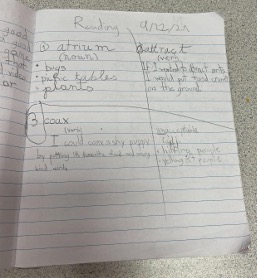
The view of a student journal during whole-group explicit vocabulary instruction.
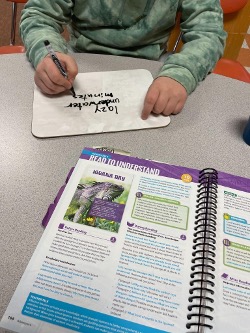
A student writes and pronounces vocabulary words during a Voyager Passport Read to Understand lesson.
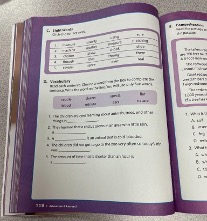
Vocabulary sentences are included in a Voyager Passport Adventure Checkpoint.
A Vocabulary-Rich Classroom
Students need multiple exposures to words before they truly own them, so the importance of a vocabulary-rich classroom cannot be overlooked. To close out this post, I will share some of my favorite ways to boost vocabulary use in an elementary classroom.
- Be intentional about the words you use when speaking to students. When giving directions, use specific words and include rich vocabulary. Then rephrase the directions in simpler terms. Go ahead and use those fancy words when you talk to students. Then stop and ask them if they know what the word means. Compliment your students when they use fancy words in their speech and writing.
- Be thoughtful about students who struggle to decode words so you can provide them with opportunities to hear rich vocabulary. These students deserve opportunities to grow their vocabulary even if they can’t do it through independent reading (yet!). Incorporate read alouds, audiobooks, and podcasts into your classroom. Let students listen to books during independent reading times.
- Point out amazing vocabulary when you see it. Reuse vocabulary words often. I’ve made it a habit to wear a different vocabulary word on a lanyard every day. I challenge my students to use that word during the day and it reminds me to use it too.
- Incorporate vocabulary activities into other areas of instruction. When sorting words with a similar phonics pattern, ask students if they know the meaning of the words. Challenge them to sort the words by parts of speech. In science, have students classify or sort words based on their relationships. Or, have students create drawings, videos, or hand gestures to help remember key vocabulary. The vocabulary possibilities are truly endless.
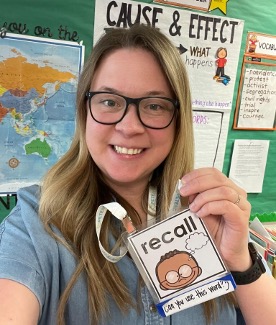
I wear a different vocabulary word each day to encourage my students and myself to use rich vocabulary throughout the day.
References:
Hennessy, N. L. (2021). The reading comprehension blueprint: Helping students make meaning from text. Paul H. Brookes Publishing.
Moats, L. C., & Tolman, C. A. (2019). LETRS (3rd ed., Vol. 1). Voyager Sopris.
Such, C. (2021). The art and science of teaching primary reading. Corwin, a SAGE Publishing Company.
